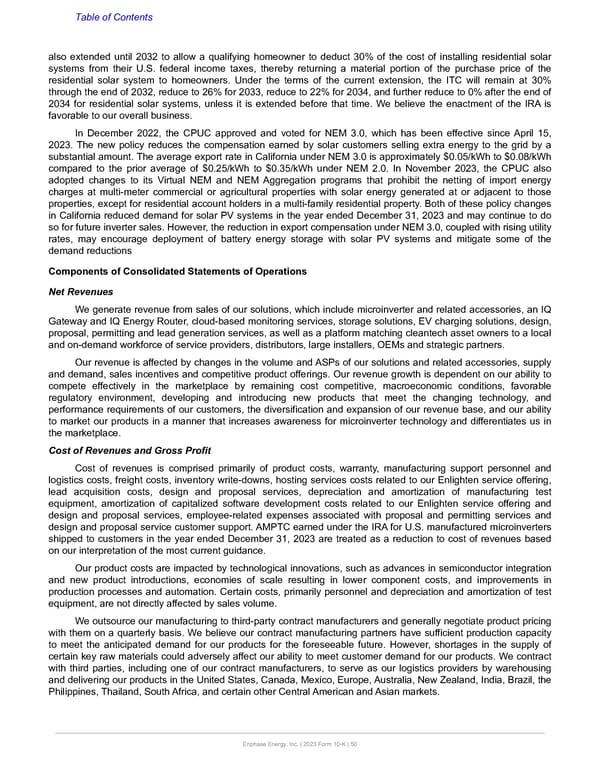Table of Contents also extended until 2032 to allow a qualifying homeowner to deduct 30% of the cost of installing residential solar systems from their U.S. federal income taxes, thereby returning a material portion of the purchase price of the residential solar system to homeowners. Under the terms of the current extension, the ITC will remain at 30% through the end of 2032, reduce to 26% for 2033, reduce to 22% for 2034, and further reduce to 0% after the end of 2034 for residential solar systems, unless it is extended before that time. We believe the enactment of the IRA is favorable to our overall business. In December 2022, the CPUC approved and voted for NEM 3.0, which has been effective since April 15, 2023. The new policy reduces the compensation earned by solar customers selling extra energy to the grid by a substantial amount. The average export rate in California under NEM 3.0 is approximately $0.05/kWh to $0.08/kWh compared to the prior average of $0.25/kWh to $0.35/kWh under NEM 2.0. In November 2023, the CPUC also adopted changes to its Virtual NEM and NEM Aggregation programs that prohibit the netting of import energy charges at multi-meter commercial or agricultural properties with solar energy generated at or adjacent to those properties, except for residential account holders in a multi-family residential property. Both of these policy changes in California reduced demand for solar PV systems in the year ended December 31, 2023 and may continue to do so for future inverter sales. However, the reduction in export compensation under NEM 3.0, coupled with rising utility rates, may encourage deployment of battery energy storage with solar PV systems and mitigate some of the demand reductions Components of Consolidated Statements of Operations Net Revenues We generate revenue from sales of our solutions, which include microinverter and related accessories, an IQ Gateway and IQ Energy Router, cloud-based monitoring services, storage solutions, EV charging solutions, design, proposal, permitting and lead generation services, as well as a platform matching cleantech asset owners to a local and on-demand workforce of service providers, distributors, large installers, OEMs and strategic partners. Our revenue is affected by changes in the volume and ASPs of our solutions and related accessories, supply and demand, sales incentives and competitive product offerings. Our revenue growth is dependent on our ability to compete effectively in the marketplace by remaining cost competitive, macroeconomic conditions, favorable regulatory environment, developing and introducing new products that meet the changing technology, and performance requirements of our customers, the diversification and expansion of our revenue base, and our ability to market our products in a manner that increases awareness for microinverter technology and differentiates us in the marketplace. Cost of Revenues and Gross Profit Cost of revenues is comprised primarily of product costs, warranty, manufacturing support personnel and logistics costs, freight costs, inventory write-downs, hosting services costs related to our Enlighten service offering, lead acquisition costs, design and proposal services, depreciation and amortization of manufacturing test equipment, amortization of capitalized software development costs related to our Enlighten service offering and design and proposal services, employee-related expenses associated with proposal and permitting services and design and proposal service customer support. AMPTC earned under the IRA for U.S. manufactured microinverters shipped to customers in the year ended December 31, 2023 are treated as a reduction to cost of revenues based on our interpretation of the most current guidance. Our product costs are impacted by technological innovations, such as advances in semiconductor integration and new product introductions, economies of scale resulting in lower component costs, and improvements in production processes and automation. Certain costs, primarily personnel and depreciation and amortization of test equipment, are not directly affected by sales volume. We outsource our manufacturing to third-party contract manufacturers and generally negotiate product pricing with them on a quarterly basis. We believe our contract manufacturing partners have sufficient production capacity to meet the anticipated demand for our products for the foreseeable future. However, shortages in the supply of certain key raw materials could adversely affect our ability to meet customer demand for our products. We contract with third parties, including one of our contract manufacturers, to serve as our logistics providers by warehousing and delivering our products in the United States, Canada, Mexico, Europe, Australia, New Zealand, India, Brazil, the Philippines, Thailand, South Africa, and certain other Central American and Asian markets. Enphase Energy, Inc. | 2023 Form 10-K | 50
 Annual Report Page 49 Page 51
Annual Report Page 49 Page 51